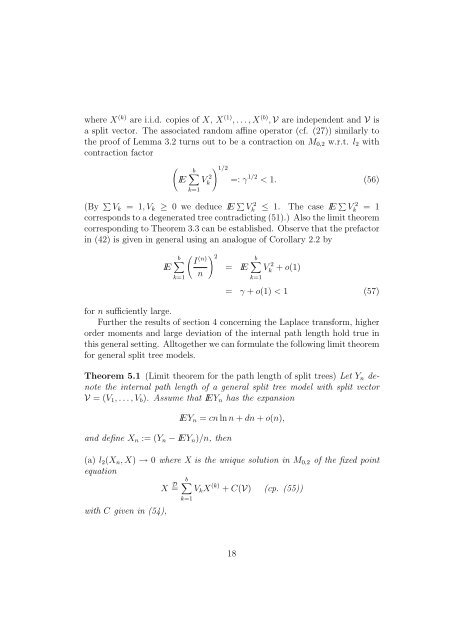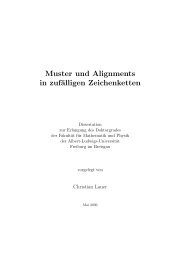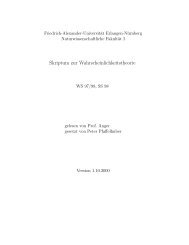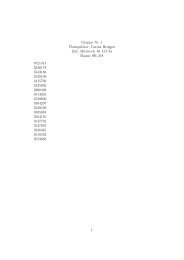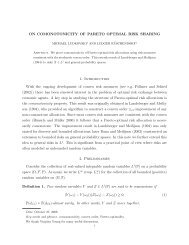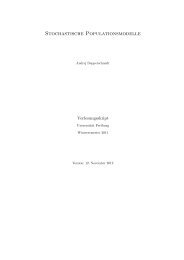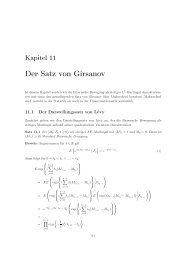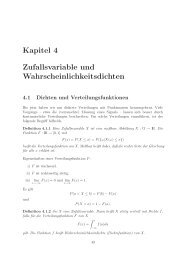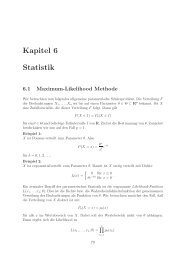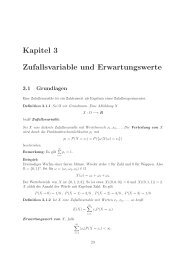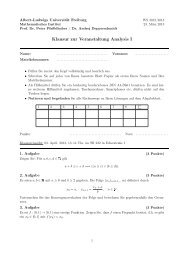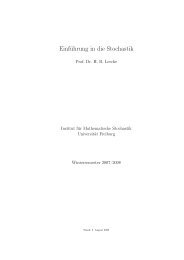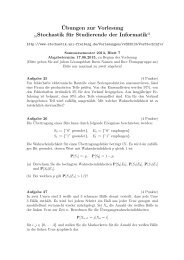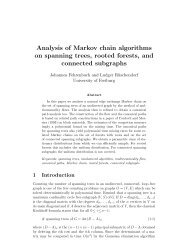On the Internal Path Length of dâdimensional Quad Trees
On the Internal Path Length of dâdimensional Quad Trees
On the Internal Path Length of dâdimensional Quad Trees
Create successful ePaper yourself
Turn your PDF publications into a flip-book with our unique Google optimized e-Paper software.
where X (k) are i.i.d. copies <strong>of</strong> X, X (1) , . . . , X (b) , V are independent and V is<br />
a split vector. The associated random affine operator (cf. (27)) similarly to<br />
<strong>the</strong> pro<strong>of</strong> <strong>of</strong> Lemma 3.2 turns out to be a contraction on M 0,2 w.r.t. l 2 with<br />
contraction factor<br />
(<br />
IE<br />
b∑<br />
k=1<br />
V 2<br />
k<br />
) 1/2<br />
=: γ 1/2 < 1. (56)<br />
(By ∑ V k = 1, V k ≥ 0 we deduce IE ∑ V 2<br />
k ≤ 1. The case IE ∑ V 2<br />
k = 1<br />
corresponds to a degenerated tree contradicting (51).) Also <strong>the</strong> limit <strong>the</strong>orem<br />
corresponding to Theorem 3.3 can be established. Observe that <strong>the</strong> prefactor<br />
in (42) is given in general using an analogue <strong>of</strong> Corollary 2.2 by<br />
( )<br />
b∑ I<br />
(n) 2 b∑<br />
IE<br />
= IE Vk 2 + o(1)<br />
k=1<br />
n<br />
k=1<br />
= γ + o(1) < 1 (57)<br />
for n sufficiently large.<br />
Fur<strong>the</strong>r <strong>the</strong> results <strong>of</strong> section 4 concerning <strong>the</strong> Laplace transform, higher<br />
order moments and large deviation <strong>of</strong> <strong>the</strong> internal path length hold true in<br />
this general setting. Alltoge<strong>the</strong>r we can formulate <strong>the</strong> following limit <strong>the</strong>orem<br />
for general split tree models.<br />
Theorem 5.1 (Limit <strong>the</strong>orem for <strong>the</strong> path length <strong>of</strong> split trees) Let Y n denote<br />
<strong>the</strong> internal path length <strong>of</strong> a general split tree model with split vector<br />
V = (V 1 , . . . , V b ). Assume that IEY n has <strong>the</strong> expansion<br />
and define X n := (Y n − IEY n )/n, <strong>the</strong>n<br />
IEY n = cn ln n + dn + o(n),<br />
(a) l 2 (X n , X) → 0 where X is <strong>the</strong> unique solution in M 0,2 <strong>of</strong> <strong>the</strong> fixed point<br />
equation<br />
b∑<br />
X =<br />
D V k X (k) + C(V) (cp. (55))<br />
with C given in (54),<br />
k=1<br />
18


